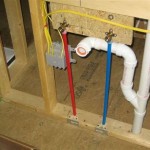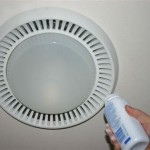How To Tighten A Single Handle Bathroom Sink Faucet
A loose bathroom sink faucet, particularly a single-handle model, can be an irritating issue. It not only feels unstable but can also lead to water leaks, potentially causing damage to the surrounding countertop and cabinet. Tightening a single-handle bathroom sink faucet is a manageable task for most homeowners, requiring a few common tools and a methodical approach. This article provides a comprehensive guide on how to diagnose the cause of the looseness and effectively tighten the faucet, ensuring its stability and proper functioning.
Before commencing any repairs, it is paramount to prioritize safety. It is recommended to turn off the water supply to the faucet. Typically, shut-off valves are located under the sink, one for hot water and one for cold. Turn both valves clockwise until they are completely closed. Once the water supply is shut off, turn on the faucet to relieve any residual pressure in the lines. If the shut-off valves are faulty or do not exist, the main water supply to the house must be shut off. In addition, place a towel or bucket under the work area to catch any remaining water or debris, preventing potential water damage to the cabinet below.
Once the water supply is secured, the next step is to identify the exact location of the source of the looseness. This will guide the tightening process. Common points of looseness include the base of the faucet where it meets the countertop, the handle itself, and the connections beneath the sink. Carefully inspect each area to pinpoint the problem.
Identifying the Cause of the Looseness
The initial step in addressing a loose faucet is to determine the precise cause of the problem. Several factors can contribute to a wobbly faucet, and understanding the underlying issue is vital for implementing the correct tightening procedure.
One frequent cause of faucet looseness is a loose mounting nut. This nut, situated underneath the sink, secures the faucet to the countertop. Over time, vibrations from regular use can gradually loosen this nut, causing the faucet to become unstable. Inspecting the mounting nut is crucial. It is generally made of metal or plastic and is directly connected to the faucet's shank, which extends through the sink's mounting hole.
Another potential issue involves the faucet's connections to the water supply lines. The supply lines are typically connected to the faucet using compression fittings or threaded connections. If these connections are not adequately tightened, they can cause the entire faucet assembly to feel loose. Carefully examine the connections where the supply lines meet the faucet body for any signs of leaks or looseness.
Furthermore, the handle of the faucet itself can become loose. This is particularly common in single-handle faucets with a set screw that secures the handle to the valve stem. If the set screw is loose or missing, the handle will wobble, creating a perceived looseness in the entire faucet. The set screw is usually located on the side or underneath the handle and often requires a small Allen wrench to tighten.
Finally, the O-rings and washers within the faucet assembly can deteriorate over time. While this does not directly cause the faucet to loosen, it can lead to leaks that weaken the overall structure and contribute to a feeling of instability. If extensive leaking is present, replacing the O-rings and washers may be necessary, which could indirectly address a loose faucet issue by restoring proper sealing and support.
Tightening the Mounting Nut
Once the source of the looseness has been identified as the mounting nut beneath the sink, the tightening process can commence. This step often requires working in a confined space, so proper preparation and the use of appropriate tools are essential.
Accessing the mounting nut typically involves positioning oneself under the sink, often in an uncomfortable position. Ensure adequate lighting by using a flashlight or a headlamp to clearly see the nut and surrounding plumbing. A basin wrench is the preferred tool for tightening the mounting nut, particularly in tight spaces. A basin wrench features a long handle and a swiveling jaw that can grip the nut from different angles. If a basin wrench is not available, an adjustable wrench may be used, although it may be more challenging to maneuver in the restricted space.
Before attempting to tighten the nut, inspect it for any signs of corrosion or damage. If the nut is heavily corroded, attempting to tighten it may cause it to break. In such cases, it is advisable to replace the nut entirely. If the nut appears to be in good condition, carefully position the basin wrench or adjustable wrench around the nut. Ensure that the wrench is securely gripping the nut to prevent slippage.
Apply gentle but firm pressure to tighten the nut. Avoid over-tightening, as this can damage the nut, the faucet shank, or the countertop. A quarter turn is often sufficient to secure the faucet. After tightening the nut, test the faucet's stability by gently wiggling it. If the faucet still feels loose, repeat the tightening process with another quarter turn. Continue this process until the faucet is securely mounted to the countertop.
If the mounting nut is made of plastic, exercise extra caution when tightening. Plastic nuts are more prone to cracking or stripping than metal nuts. Tighten the plastic nut only until it is snug and the faucet is stable. Over-tightening a plastic nut can easily result in damage and necessitate replacement.
In some cases, the mounting nut may be difficult to reach due to obstructions from plumbing or other fixtures. If this is the case, consider temporarily removing the obstructing components to gain better access to the nut. Be sure to carefully document the arrangement of the removed components to ensure proper reinstallation.
Addressing Loose Handle and Supply Line Connections
If the looseness stems from the faucet handle or the connections to the water supply lines, different tightening procedures are required. These steps focus on securing the specific areas that are causing the wobble.
For a loose faucet handle, the primary culprit is usually a loose set screw. Locate the set screw, which is generally found on the side or underside of the handle. The set screw typically requires a small Allen wrench (also known as a hex key) for tightening. Insert the appropriate size Allen wrench into the set screw and turn it clockwise until the handle is securely fastened to the valve stem. Avoid over-tightening the set screw, as this can damage the screw or the handle. If the set screw is missing, it will need to be replaced with a matching screw from a hardware store.
If the handle itself is damaged or stripped, simply tightening the set screw might not be sufficient. In such cases, it may be necessary to replace the entire handle assembly. Consult the faucet's manufacturer or a parts supplier to obtain a compatible replacement handle.
When dealing with loose supply line connections, the process involves tightening the compression fittings or threaded connections where the supply lines meet the faucet body. Use two wrenches for this task. One wrench should hold the faucet body steady, while the other wrench tightens the fitting on the supply line. This prevents the fitting from rotating and potentially damaging the faucet. Tighten the fitting until it is snug but not excessively tight. Over-tightening can damage the fitting or the supply line, leading to leaks.
Before tightening the supply line connections, inspect the fittings for any signs of corrosion or damage. If the fittings are corroded, they may need to be replaced. Similarly, if the supply lines are old or damaged, consider replacing them entirely. Using new supply lines and fittings can ensure a secure and leak-free connection.
After tightening the supply line connections, carefully inspect for any leaks. Turn the water supply back on slowly and observe the connections for any signs of dripping or moisture. If leaks are present, try tightening the connections slightly further. If the leaks persist, it may be necessary to disassemble the connections and inspect the threads for damage or the presence of debris. Clean the threads thoroughly and reassemble the connections, using Teflon tape or pipe sealant to ensure a watertight seal.
Following the successful tightening, the faucet should be stable and operate smoothly. It is recommended to periodically check the tightness of all connections and mounting hardware to prevent future loosening and potential leaks. Regular maintenance can extend the lifespan of the faucet and prevent more significant plumbing problems.

How To Fix A Leaky Single Handle Sink Faucet

How To Tighten Faucet Handle Homeserve Usa

How To Fix A Faucet Tighten Kitchen Sink Handle

How To Fix A Leaky Single Handle Sink Faucet

How To Tighten A Bathroom Faucet Handle

How To Tighten Moen Bathroom Faucet Handle Bargain

How To Repair A Single Handle Kitchen Faucet Diy Family Handyman

How To Fix A Leaky Bathroom Sink Faucet

How To Rebuild A Delta Single Handle Faucet

How To Replace Repair A Leaky Moen Cartridge In Bathroom Set Of Faucets Single Lever Tips
Related Posts







